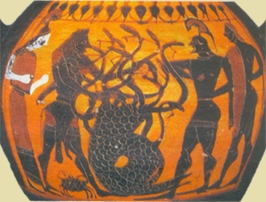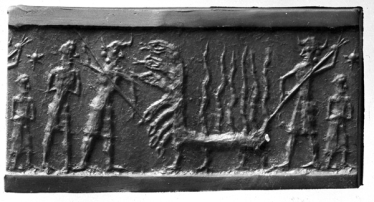Text
The Hydra which lived in the swamps near to the ancient city of Lerna in Argolis had the body of a serpent and many heads of which one could never be harmed by any weapon, and if any of the other heads were severed another one or two would grow in its place. Also the stench from the Hydra’s venomous breath was enough to kill man or beast. When it emerged from the swamp it would attack herds of cattle and local villagers, devouring them with its numerous heads. Heracles journeyed to Lake Lerna in a speedy chariot, and with him he took his nephew and charioteer Iolaus, in search of the dreaded Hydra. When they finally reached the Hydras’ hiding place, Heracles told Iolaus to stay with the horses while he drew the monster from its hole with flaming arrows. In Mesopotamia, the slaying of a seven-headed serpent was one of the traditional exploits of Ninurta. It also has a well-defined place in the Canaanite mythology, where the beast is the Ugaritic Lotanu, the biblical Leviathan, the dragon of the sea that is vanquished by the storm-god (Baal, Yahweh). In some Mesopotamian seals, going back before 2000 BCE, depict scenes strongly reminiscent of this Heracles’ achievement. We see divine or human heroes armed with a club and a bow, and occasionally dressed in animal skins, even a lion-skin. Some representations show one or two figures fighting many-headed, usually seven-headed serpent or monster.
Some versions say that while Heracles fought the Hydra the goddess Hera sent down a giant crab which attacked his feet. This legend comes from a marble relief dating from the 2nd century BCE found at ancient Lerna, showing Heracles attacking the Hydra, and near his feet is a huge crab. This alliance between serpent and crab is perhaps foreshadowed in a couple of Mesopotamian seals. On one of the earliest the combat between the hero and the seven-headed serpent is framed by scorpions, one of which is located immediately behind the hero. A Neo-Assyrian seal of the ninth or eighth century shows a man aiming an arrow at a huge scorpion and snake which rear up vertically before him.
Bibliography
| Frankfort 1955, no. 478 | Frankfort, Henri. Stratified Cylinder Seals from the Diyala Region. The University of Chicago Oriental Institute Publications 72. Chicago IL: University of Chicago Press 1955. [PDF] |
| West 1997, 460-461 | West, Martin L. The East Face of Helicon. West Asiatic Elements in Greek Poetry and Myth. Oxford: Clarendon Press 1997. |
Amar Annus
URL for this entry: http://www.aakkl.helsinki.fi/melammu/database/gen_html/a0001288.php
|


